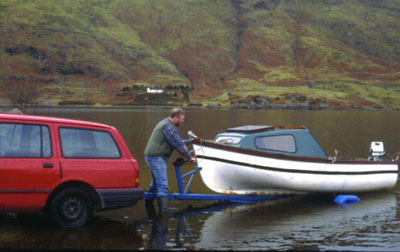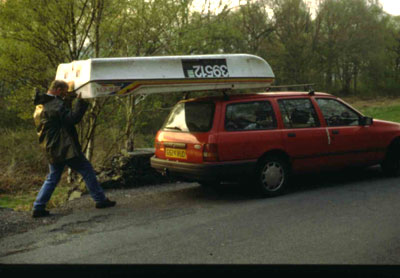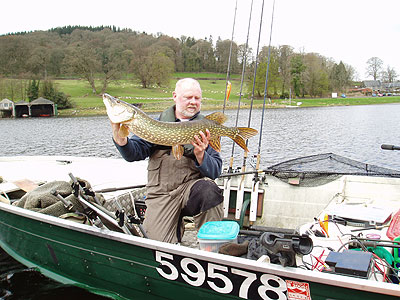Boat fishing is something of a mystery to many anglers. Most would agree that the ability to get afloat can pay dividends and yet very few anglers actually take the plunge and give it a go. Those that do fall mainly into two categories; the experienced boater who’s learned the art of boat fishing the hard way and the casual boat fisherman who perhaps just goes afloat once a year while on holiday.
Many casual boaters find their first experience less than rewarding and in a lot of cases, it’s enough to put them off boats for life. Make no mistake, it’s a lot easier to get it wrong than to get it right in boat fishing and the potential is there to get it wrong with the most disastrous of consequences.
During this series I hope to give an insight into fishing from a boat, how to choose wisely, where to use your craft, how to be safe and how to use your boat to its best advantage. I should stress at this point that my own interest is in coarse fishing on lakes and rivers and all that I write here is done so with this in mind. There are obviously much greater safety implications involved for those who wish to venture out on the sea in a small boat and many of the principles I adopt would not be appropriate out at sea.
 The Golden Rule
The Golden Rule
Safety is paramount in boat fishing and the safety thread will continue through these articles. This is exactly how it should be in boating, for safety is not a bolt-on afterthought but rather something that should be considered in the making of every decision. So in choosing your boat, think about what will be the safest option. Is the boat going to be used on a big water or a small one? On a river or a lake? Are there rocky outcrops or dense weed? Above all, how many people do you expect to be in your boat at any one time? Two people fishing from a twelve foot boat is a squeeze and three would be quite dangerous so think about this when you make your choice.
Before going out and spending your hard earned dosh, it really is important to decide what you are going to use your boat for, what facilities are available and what restrictions are imposed. Looking around your local waters, you will probably find that access is very limited and that in many cases, boating is not allowed. This is in stark contrast to many other countries such as the USA or Spain, a country where I’ve done a fair bit of boat fishing. So, the first important point to consider is whether you can actually launch at all! Assuming you can put a boat out, what kinds of restrictions are going to be imposed upon you? The majority of waters I fish have speed limits ranging from as low as 5mph. Other restrictions may involve a limit on the engine capacity of any outboard you may wish to use or even ban the use of outboards altogether. This may be no bad thing at times – contributing to a quieter and cleaner environment for us all, though I am often at a loss to understand why some places ban the use of electric outboards, which are both silent and pollution-free.
Horsepower for courses
Many first-time boaters will be happy to settle for what they can get in terms of a bargain boat. This is fine as long as the boat is suitable for the intended purpose but can be a burden if the boat is not suitable. Buying a cathedral hulled speed machine with a 50hp motor might provide fuel for the ego but it’s of little use if the local river has a 6 knot speed limit. The big engine would work out expensive to run and maintain, it would be cumbersome to store and to launch and would be a potential target for thieves – a big worry when you own a boat. Likewise, a ten-foot, flat bottomed dinghy would not be suitable for a big glacial lake like Loch Lomond or Windermere where a big wave might flip it over.
On the whole, while fast boats are nice to have, especially when fishing a big water with no restrictions, they are really not necessary for most situations and can be a liability. For small waters and rivers, the beginner to boat fishing should look more towards a boat of 12 to 14 feet with an engine that will push it at around 5 or 6 mph. A 4hp engine will suit a 12 foot boat quite nicely while an 8hp engine will do just fine for a 14 footer. Much depends on the type of hull the boat has. A displacement hull pushes through the water when on the move while a planing hull rides over it. Generally, a boat with a planing hull will take a bigger engine and will travel much faster.
 I have two boats at the moment, a ten foot plastic boat and a 14 foot Quicksilver aluminium. My ten footer is ideal for use in places where launching is a problem. It is light enough to get on the car roof, weighing just 90lbs and can be launched even down a sheer drop by lowering it with a rope. It’s called a sniper 10, the second one I’ve had and I wouldn’t be without it. I find that a 4hp engine or my 55lb thrust electric push it along at a nice speed and the manufacturers recommendation is for an engine size no greater than 6hp on this little boat. Fitting a larger engine would be of little use, causing the boat to sit up in the water rather than travel faster and wasting much fuel at the same time
I have two boats at the moment, a ten foot plastic boat and a 14 foot Quicksilver aluminium. My ten footer is ideal for use in places where launching is a problem. It is light enough to get on the car roof, weighing just 90lbs and can be launched even down a sheer drop by lowering it with a rope. It’s called a sniper 10, the second one I’ve had and I wouldn’t be without it. I find that a 4hp engine or my 55lb thrust electric push it along at a nice speed and the manufacturers recommendation is for an engine size no greater than 6hp on this little boat. Fitting a larger engine would be of little use, causing the boat to sit up in the water rather than travel faster and wasting much fuel at the same time
This is a principle that many people fail to grasp, the engine size must be suited to the size and style of the boat. I once witnessed a very experienced angler who had fitted an engine far too large for the boat he was using. The result was that he got nowhere fast, the boat sitting up like a performing poodle in the water and after a relatively short space of time the boat’s transom was badly damaged
The size of the engine will impact too on your flexibility. A 4hp engine with an integral fuel tank is a handy size to carry around and can be fitted to your boat single-handedly in seconds. Larger engines than this tend to have remote fuel tanks which take up room in the boat and make them a little more difficult to transport. Engines of greater than 8hp are pretty heavy and large engines cannot easily (safely) be fitted by an individual. That’s ok if you’re intending to leave your engine fastened to the boat all the time but that makes them a target for thieves. Moreover, if you are likely to want use your engine on a hire boat from time to time you will want something you can transport easily.
Flexibility is the key. My little sniper is remarkably stable and I’ve landed some pretty big fish in it – fish of over a hundred pounds! It has its limitations however. Being so light, it tends to sit on the water rather than in it. This makes it very susceptible to being blown about by the wind and I would not consider using it in windy weather – particularly on a big water. It is also rather too small for two, especially in the winter when all the extra clothing, waterproofs, flasks and food seem to take up more space than they do on the bank. Moreover, being an open boat with no shelter makes it pretty uncomfortable when that east wind blows.
 What material?
What material?
Material of construction is something that needs to be considered. Fibreglass boats like the one mentioned above or the excellent Orkney range are low maintenance and fairly easily repaired. They are heavy and quite susceptible to damage however and this should be taken into account if they are to be used on waters where rocks are a problem. Aluminium boats like the Sea Nymph, Sea Strike or Quicksilver are the favourite for many anglers. They are light and very tough but quite expensive to buy and they never seem to find their way onto the second-hand market. Plastic is another material worthy of consideration. My little ten foot “Sniper” is plastic and has lasted me for many years, while a Swedish company called Pioneer has brought out an superb range of plastic boats which seem almost indestructible – these boats are becoming a favourite amongst those who fish the rocky glacial lakes. Wooden boats tend to be heavy which makes them difficult to launch and they are rather too high-maintenance for my liking. A heavy boat is hard to launch and to retrieve and you should consider your own capabilities in this respect. I well remember bumping into the late and much lamented James Holgate on a big lake a couple of years ago having just launched his large boat. Jim was pumping sweat and confided in me that as he had got older, he was finding it more and more difficult to handle the big boat and indeed, shortly afterwards, he traded it in for a smaller, lighter craft.
For many years I used a 14ft fibreglass boat with a displacement hull. This was a boat I bought from a friend and was typical of the type of second-hand boat one might find on ebay or the second-hand pages of the local newspaper. It was a very wide-bottomed boat which made it rather slow but comfortable to fish from and the small cuddy was a blessing in bad weather. I coupled this up with a 9.9hp Honda four-stroke. Four stroke engines are much cleaner and quieter than two strokes, making them the ideal choice for anglers. Get one with electric start if you can, it will make a big difference, especially in cold weather when an engine may need a bit of turning over to get it to fire up. That engine pushed my boat along at about 8mph – quite enough for most waters. My old 14ft boat was really very inexpensive to buy, costing only £250 but it came on a rather tatty trailer. I got quite a shock when I came to replace the trailer – they cost a fortune! A new galvanised trailer for my boat would have set me back £800 and instead I decided to set to and make one. This was not as arduous as you might think and with the help of a couple of friends and a little over £200’s worth of parts I put together a trailer which was as sturdy and reliable as any you could buy from a dealer.
This boat was somewhat difficult to launch however, needing a proper slipway to do so. It was also fairly heavy and could not be manoeuvered easily without the use of the car. This is a significant disadvantage at some venues so you should really consider what launching facilities you have available to you before buying your boat. On one of the places I fish, the slipway doesn’t open to vehicles until 9am. This is hopeless for fishing, you really want to be out for dawn and so many people won’t use the public slipway but choose to launch down a gravel slope in another part of the fishery. Launching and retrieving on a loose surface can be very difficult, particularly if your car has front wheel drive and if your boat and trainer are heavy.
In time these limitations caused me to trade in the old displacement hull and buy the aluminium. This boat is quick, light, easy to launch and easy to tow. I currently have a 20hp Tohatsu four-stroke bolted onto this and the two are well matched giving a top speed of around 20knots coupled with very smooth slow-running performance, ideal for trolling or slipping quietly into a tight little swim. The boat has a fairly high freeboard, which basically means that there’s a long way between the top of the gunwale and the surface of the water. Having a high freeboard enables the boat to deal with choppy water much better and makes it necessary to use a longshaft engine.
Next time I want to talk about using your boat, how to anchor properly and what kinds of equipment should you buy and fit.
Eric Edwards










